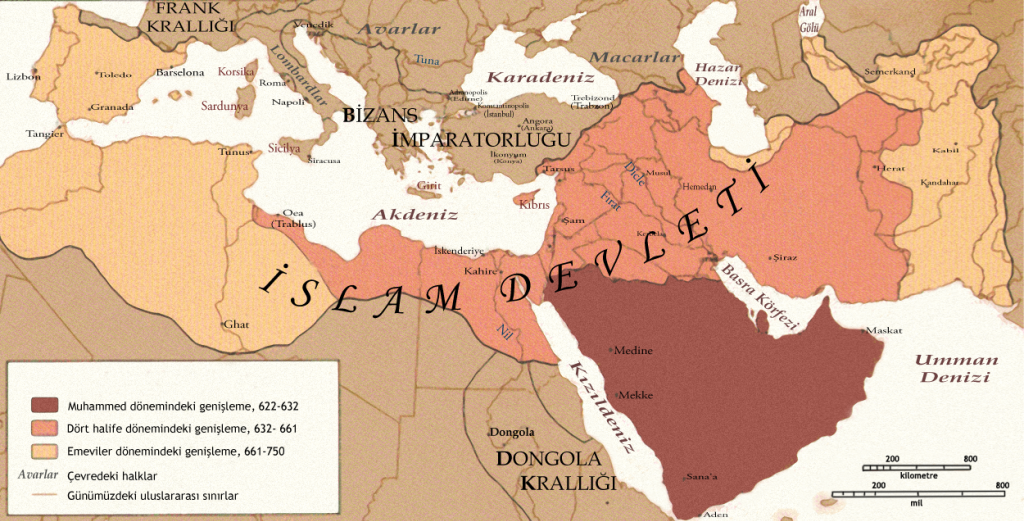
The Rashidun Caliphate (Arabic: الخلافة الراشدة, al-Khilāfa al-Rāšidah; 632–661) was the first of the four major caliphates established after the death of the Islamic prophet, Muhammad. It was ruled by the first four successive caliphs (successors) of Muhammad after his death in 632 CE (AH 11). These caliphs are collectively known in Sunni Islam as the Rashidun, or "Rightly Guided" caliphs (اَلْخُلَفَاءُ ٱلرَّاشِدُونَ al-Khulafā’ur-Rāshidūn). This term is not used in Shia Islam as Shia Muslims do not consider the rule of the first three caliphs as legitimate.[2]
The Rashidun Caliphate is characterized by a twenty-five year period of rapid military expansion, followed by a five-year period of internal strife. The Rashidun Army at its peak numbered more than 100,000 men. By the 650s, the caliphate in addition to the Arabian Peninsula had subjugated the Levant, to the Transcaucasus in the north; North Africa from Egypt to present-day Tunisia in the west; and the Iranian plateau to parts of Central Asia and South Asia in the west.
The caliphate arose out of the death of Muhammad in 632 CE and the subsequent debate over the succession to his leadership. Abu Bakr, a close companion of Muhammad from the Banu Taym clan, was elected the first Rashidun leader and began the conquest of the Arabian Peninsula. He ruled from 632 to his death in 634. Abu Bakr was succeeded by Umar, his appointed successor from the Banu Adi clan, who began the conquest of Persia from 642 to 651, leading to the defeat of the Sassanid Empire. Umar was assassinated in 644[3] and was succeeded by Uthman, who was elected by a six-person committee arranged by Umar. Under Uthman began the conquest of Armenia, Fars and Khorasan.[4] Uthman was assassinated in 656[5] and succeeded by Ali, who presided over the civil war known as the First Fitna (656–661). The war was primarily between those who supported Uthman's cousin and governor of the Levant, Muawiyah, and those who supported the caliph Ali. The civil war permanently consolidated the divide between Sunni and Shia Muslims, with Shia Muslims believing Ali to be the first rightful caliph and Imam after Muhammad.[6] A third faction in the war supported the governor of Egypt, Amr ibn al-As. The war was decided in favour of the faction of Muawiyah, who established the Umayyad Caliphate in 661.
四大哈里发或正统哈里发(阿拉伯文:الخلفاء الراشدون)是指伊斯兰教创始人穆罕默德逝世后自632年至661年相继执掌阿拉伯伊斯兰国家政教大权的四位继承人(即哈里发),他们分别是阿布·伯克尔、欧麦尔·本·赫塔卜、奥斯曼·本·阿凡和阿里·本·阿比·塔利卜。由于四大哈里发都是通过民主选举或推举而产生的,他们的继位获得了大多数穆斯林的认可,故称这一时期为哈里发国家的“神权共和时期”。
逊尼派穆斯林承认四位哈里发都是先知穆罕默德的合法继承人,故有“正统”之称,而什叶派穆斯林只承认阿里及其后裔是合法的哈里发,视阿里之前的三位哈里发为篡位者。
正统哈里发在位期间,新生的阿拉伯伊斯兰政权得到了巩固,并开始了大规模的对外征服(穆斯林称之为圣战),传播了伊斯兰教,为阿拉伯帝国的形成奠定了基础。
第四位“正统哈里发”阿里遇刺后,继哈里发之位的其子哈桑·本·阿里·本·阿比·塔利卜不久就在叙利亚总督穆阿威叶的威逼利诱下放弃哈里发之位,穆阿威叶继任哈里发,哈里发国家的“神权共和”时期结束,开始了世袭制的倭马亚王朝。
Les califes bien guidés (en arabe : اَلْخِلَافَةُ ٱلرَّاشِدَةُ al-Khilāfātu al-Rāshidatu)(632-661) désignent les quatre premiers califes. Cette appellation vient du fait qu'ils sont considérés dans l'islam sunnite comme des chefs modèles qui ont suivi scrupuleusement la voie de Mahomet. Ils étaient pour la plupart les compagnons très proches du prophète. Leur succession, pas héréditaire à la base deviendra la coutume[pas clair] pour les successions musulmanes postérieures. Le concept et la dénomination de « califes bien guidés » a été créé postérieurement, par la dynastie abbasside, et sa dénomination est inspirée par le hadith où Mahomet a dit : « Tenez fermement à mon exemple (sunna) et celui des califes bien guidés1 ».
L'espressione Califfato dei Rāshidūn (in arabo: خلافة ﺍﻟﺮﺍﺷﺪﻭﻥ, Khilāfat al-Rāshidūn), ossia "Califfato degli Ortodossi", identifica il trentennio circa di storia islamica (632-661) in cui la Umma fu retta dai quattro Califfi Abū Bakr, ʿUmar ibn al-Khattāb, ʿUthmān b. ʿAffān e ʿAlī b. Abi Tālib. L'essere stati tra i musulmani più illustri per anzianità di fede (sābiqa) e per parentela o affinità col profeta Maometto (karāba), e l'essere stati prescelti in base a criteri di efficienza e non di appartenenza familiare, li ha fatti definire dai musulmani come "ortodossi" (rāshidūn).[2]
El califato bien guiado o califato Rashidun (en árabe: الخلفاء الراشدون al-ḫulafāʔ al-rāšidūn) es el nombre que se da en la tradición musulmana sunní a los cuatro primeros califas que sucedieron a Mahoma, desde el 632 al 661. En muchas lenguas europeas se les conoce también como califas ortodoxos. Los sunníes de lengua urdu a veces les llaman los cuatro amigos (چار یار, chaar yaar) y a su dominio el reinado de los cuatro califas.
Algunos incluyen a Hasan ibn Ali, hijo de Alí, como el quinto califa rāshid.
Según los chiíes, el primer califa fue Alí seguido de los imames chiíes, pues aducen que esta sucesión la decidió el mismo Mahoma.
Para los jariyitas (abadíes), no hubo más que dos califas bien guiados, ya que, en su opinión, sólo parte de los califatos de Uthmán y Alí ibn Abi Tálib fueron bien guiados.
Пра́ведный халифа́т (араб. الخلافة الراشدية) — государство, созданное после смерти пророка Мухаммеда в 632 году. Халифат последовательно возглавляли четыре праведных халифа: Абу Бакр, Умар ибн аль-Хаттаб, Усман ибн Аффан и Али ибн Абу Талиб. Территория халифата включала Аравийский полуостров, Шам, Кавказ, часть Северной Африки от Египта до Туниса и Иранское нагорье. Праведный халифат положил начало Арабскому халифату.






